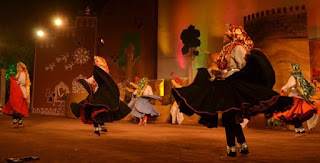Raja Maharana Paratap
In 1568 during the reign of Pratap's father, Udai Singh II, Chittor Fort was conquered by the Mughal emperor Akbar after the third Jauhar.[Udai Singh and his family had left before the capture and moved to the foothills of the Aravalli Range where Udai Singh had already founded the city of Udaipurin 1559.[5] Rani Dheer Bai wanted her son Jagmal to succeed Udai Singh[6] but senior courtiers preferred Pratap, as the eldest son, to be their king. The desire of the nobles prevailed.[citation needed]
Battle of Haldighati[edit]
The grim Siege of Chittorgarh in 1568 had led to the loss of the fertile eastern belt of Mewar to the Mughals. However, the rest of the wooded and hilly kingdom was still under the control of the Rana. The Mughal emperor Akbarwas intent on securing a stable route to Gujarat through Mewar; when Pratap Singh was crowned king (Rana) in 1572, Akbar sent a number of envoys entreating the Rana to become a vassal like many other Rajput leaders in the region. When the Rana refused to personally submit to Akbar, war became inevitable.[7][8]
The Battle of Haldighati was a battle fought on 18 June 1576 between Maharana Pratap and Akbar's forces led by Man Singh I of Amber. The Mughals were the victors and inflicted significant casualties among the Mewaris but failed to capture Pratap, who escaped. The site of the battle was a narrow mountain pass at Haldighati near Gogundain Rajasthan. Maharana Pratap fielded a force of around 3,000 cavalry and 400 Bhil archers. The Mughals were led by Raja Man Singh of Amber, who commanded an army numbering around 5,000–10,000 men. After a fierce battle lasting more than three hours, Pratap found himself wounded and the day lost. While a few of his men bought him time, he managed to make an escape to the hills and lived to fight another day. The casualties for Mewar numbered around 160 men. The Mughal army lost 1500 men, with another 350 wounded.[9]
Haldighati was a futile victory for the Mughals, as they were unable to oust Maharana Pratap. While they were able to capture Gogunda and nearby areas, they were unable to hold onto them for long. As soon as the empire's focus shifted elsewhere, Pratap and his army came out of hiding and recaptured the western regions of his dominion.[10]
After the Battle of Haldighati[edit]
On the third day after the Battle of Haldighati, on 23 June 1576, Man Singh I conquered Gogunda[11] which was later recaptured by Pratap in July 1576.[12] Pratap then made Kumbhalgarh his temporary capital.[13] After that, Emperor Akbar decided to personally lead the campaign against Pratap.[citation needed] In the process, Gogunda, Udaipur and Kumbhalgarh were occupied by the Mughals, forcing the Rana deeper into the mountainous tracts of southern Mewar.[citation needed] Mughal pressure was exerted on the Afghan chief of Jalor, and the Rajput chiefs of Idar, Sirohi, Banswara, Dungarpur, and Bundi. These states, situated on the borders of Mewar with Gujarat and Malwa had traditionally acknowledged the supremacy of the dominant power in the region. Consequently, the rulers of these states submitted to the Mughals. A Mughal expedition was also sent to Bundi where Duda, the elder son of Rao Surjan Hada, had collaborated with Pratap to take control over Bundi and adjacent areas. Both Surjan Hada and Bhoj, the father and younger brother of Duda, took part in this conflict in support of the Mughals. After a Mughal victory, Duda escaped to the hills and Bundi was conferred upon Bhoj. At this point Pratap found himself isolated and marginalised in Rajput affairs.[14][page needed]
Resurgence[edit]
Mughal pressure on Mewar relaxed after 1579 following rebellions in Bengal and Bihar and Mirza Hakim's incursion into the Punjab. In 1585, Akbar moved to Lahore and remained there for the next twelve years watching the situation in the north-west. No Mughal expedition was sent to Mewar during this period. Taking advantage of the situation, Pratap recovered many of his lost territories including Kumbhalgarh, Udaipur, Gogunda, Ranthambore and the areas around Chittor, although not Chittor itself. During this period, he also built a new capital, Chavand, near modern Dungarpur.[14][page needed] His successful defiance of Mughals using guerrilla strategy also proved inspirational to figures ranging from Shivaji to anti-British revolutionaries in Bengal.[15][unreliable source?]
Death and legacy[edit]
Reportedly, Pratap died of injuries sustained in a hunting accident[16] at Chavand, which served as his capital,[17] on 29[citation needed] January 1597, aged 57.[18] A chhatri (monument) at the site of Pratap's funeral in Chavand is an important tourist attraction.[unreliable source?]
According to Satish Chandra -
Beautiful poem
पीथल और पाथल



















